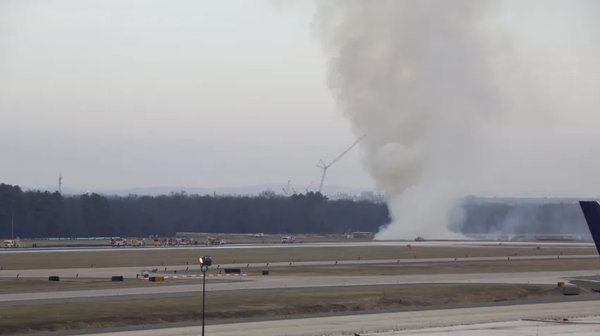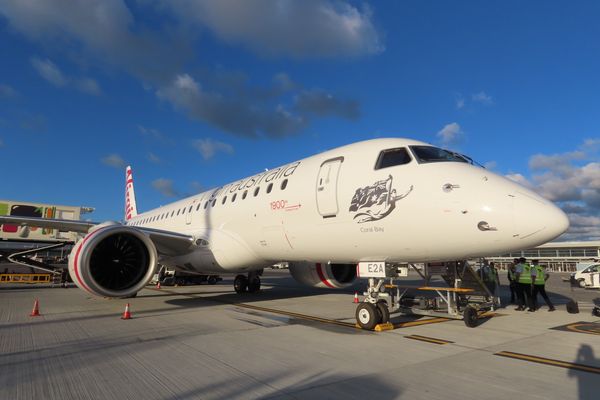Not even a full 62 years had passed between the Wright Brothers’ first powered flight near Kitty Hawk, NC, and the day Boeing Airplane Company pulled engineer Joe Sutter off the 737 development program to work on its latest idea, the 747. Pan American Airways, already thrilled by the success of the 707 that fully ushered in the jet age, had requested an airplane that could hold at least 2-1/2 times the 707’s capacity. Pan Am went as far as placing an order for 25 of the undeveloped airliners in 1966. Construction on a purpose-built factory building for 747 production began at Paine Field in Everett, WA, in June of that year. It would become the world’s largest building by interior volume.
The prototype 747, “City of Everett,” was rolled out on September 30, 1968. Thousands of Boeing employees stood on the ramp to see the giant plane emerge into the sunshine for the first time. Resplendent in white with a bold red stripe down the fuselage length, “City of Everett” was adorned with the logos of 26 airlines eagerly anticipating its arrival. Twenty-six uniformed flight attendants flew in from around the world to represent the delivery airlines. Joe Sutter recalled an audible gasp as people realized just how big it was.
The 747 was a sight to behold. The first wide-body aircraft, the term “jumbo jet” was coined just to describe it. It was 231 get long, and the tail stood six stories high. The cockpit resided on an upper deck above the passenger cabin, with a distinguishing hump behind it that provided room for more passenger seats or a lounge (American Airlines even installed a Wurlitzer organ for entertainment in their lounge design). It could hold up to 539 passengers in a single class configuration, or more commonly, 420 passengers in 32 first class and 388 economy class seats.
“City of Everett” first flew in February 1969, a momentous year in aviation that would also see the maiden flight of the supersonic Concorde and NASA’s successful Apollo rocket transporting mankind to the moon and back. The four Pratt & Whitney JT9D high bypass turbofan engines that powered the 747 produced 44,000 pounds of thrust and provided enough electricity to power four middle-class homes each. The 747’s maximum take-off weight approached 700,000 pounds. Yet despite its size, the 747 boasted a cruise speed of .85 Mach and a maximum speed of .92 Mach, making it the fastest subsonic airliner yet. Boeing test pilots tested it up to .99 Mach. After receiving FAA certification in December, Pan Am proudly delivered the first 747-100 for passenger service the following month.
Since then, 1,574 examples of aircraft have been built, from the prototype to the last 747-8, and delivered to Atlas Air in January 2023. It is ubiquitous in modern culture. It has been estimated that the equivalent of more than 1/4 of the world’s population has flown in a 747.
In all of aviation history, only six aircraft have ever flown that are larger than the 747. The only one of those six that predated the 747 was Howard Hughes’ H-4 Hercules flying boat, the Spruce Goose, which flew only once in 1947, airborne for a single mile. Of the other five, only one is an airliner, the 1.2 million pound Airbus A380, of which 251 were built between 2006 and 2021.
It’s been 59 years since the 747 design process began and 55 since the first flight. The number of years Boeing dedicated to manufacturing and delivering brand new 747s stands at 56 (1967-2023). Let that sink in: 747s were being built for nearly half of the entire 120-year existence of powered flight. Remarkably, hundreds of 747s are still in airline service today.
Various models of the 747 have come to life over the decades, starting with 205 747-100s. Almost four hundred 747-200s were built between 1971 and 1991. The 747SP, or Special Performance model, was created with a shorter fuselage to hold fewer passengers but enjoy an extended range. The 747SP also held the distinction of having the highest service ceiling of any subsonic passenger jet, capable of cruising at 45,100 feet.
747-300s were built between 1983 and 1990. The-300 stretched the hump another 23 feet to allow upper deck seating, and the iconic interior spiral staircase was replaced with a straight flight of stairs. Japan Air Lines ordered a short-range version of the 747-300 for its domestic market, providing seating for up to 584 passengers.
By far, the most popular model of the 747 was the 747-400. Modernized with a glass cockpit, the -400 eliminated the flight engineer’s position and was thus flown by a two-pilot crew. It first entered service in Feb. 1989 with Northwest Airlines. Between passenger and freight models, 694 747-400 models were built.
After the 747-400, a number of variants achieved some level of consideration, ultimately culminating in the 747-8. It is the largest of the 747 lines, 250 feet long and a wingspan of 255 feet. The -8 also came in both freighter and passenger versions, with the 747-8F entering service in 2011 and the 747-8i (Intercontinental) delivered in 2012. 108 and 47 examples of each were built, respectively.

747s Currently In Service
Remarkably, 416 Boeing 747s are still flying. There are just a handful of the earlier models, the 747-100 through 747-300, still flying. Reportedly, one is a 747-100 model operated by the Iranian Air Force. The Sands Corporation of Las Vegas Hotel fame operates one of three 747SPs that still take to the air. However, most of the existing operational fleet comprises 747-400s and the virtually new 747-8s, which are vital in cargo operations worldwide.
Cargo carrier Atlas Air maintains the largest fleet of 747s in the world, with five 747-400s, 35 747-400Fs, and 9 747-8Fs, a total of 49. UPS operates 42 747s, including 13 -400Fs, and the world’s largest fleet of 747-8s, with 29.
Luxembourg’s flag carrier, Cargolux, flies its 29 747s, 15 -400Fs and 14 -8Fs, to 90 global destinations. Kalitta, the cargo airline founded by accomplished drag racer Conrad “Connie” Kalitta, operates 21 747-400Fs. And rounding out the top five 747 cargo operators is Cathay Pacific of Hong Kong, with six -400Fs and 14 -8Fs.

Passenger 747s Still Flying
If you are looking for the passenger experience of flying on The Queen of the Skies, the opportunities are still diminishing. Economics has played the greatest role in reducing the 747 passenger fleet. Some of the most recognizable 747 liveries of all time have been long gone, such as Pan Am’s fleet of Clipper Ships (the company ceased operations in 1991) or the bold red stripes of Trans World Airlines, whose last of 35 747s soldiered on until the year 2000, a year before TWA was purchased by American Airlines. It may be interesting to note that because TWA sold at least a half-dozen of its 747-100s to the Iranian Air Force in the latter part of the 1970s, the sole -100 flying today may be one of TWA’s. Additionally, the 747SP, still operated by the Las Vegas Sands Corporation, is one of two that once belonged to TWA.
To enjoy 747 service today, you may choose Air China, which operates three 747-400s and seven 747-8i’s in passenger service. Air China also operates one 747-400F for cargo. Korean Airlines flies nine 747-8i’s in passenger service and 11 747s in cargo service, a mix of -400Fs and -8Fs.
However, the largest remaining passenger fleet of 747s is Lufthansa’s. Its eight 747-400s and 19 -8i’s serve 11 countries from Lufthansa’s hub in Frankfurt.

World Records
The 747 lives up to its Queen of the Skies name by holding some interesting world record accomplishments in passenger service. 747-8s can fly on long routes. The longest by distance: 7,152 miles between Seoul and Atlanta, GA is operated by Korean Air (15 hours and 40 minutes en route). The longest flight by flight time, 16 hours and 30 minutes (6,838 miles), is flown by Air China, connecting Beijing to New York.
The world record for the most people ever carried in a single airplane flight is an astonishing 1,088, set in 1991 when an El Al 747 took part in Operation Solomon, the relocation of more than 14,500 Ethiopian Jews to Israel. Of the three dozen aircraft employed in the airlift, one was an El Al 747. Stripped of its seats, the intention was that 760 passengers would be carried. However, due to the low body weights of many of the malnourished passengers and the lack of belongings, 1,086 total people eventually took off from Addis Ababa for Ben Gurion Airport. Two women gave birth during the flight, making the total 1,088 people upon landing.

How Long Will the 747 Last?
It is difficult to say when the last 747 might grace the skies. If a 747-100 built in the 1970s and 747SPs manufactured in the 1980s are still active today, they provide evidence that a well-maintained 747 airframe lifespan approaches 40-50 years. The entire fleet of roughly 400 747-400s and 747-8 aircraft is no older than 30 years at present. The last 747-8 delivered to Atlas Air is barely a year old.
Technically, there are still two 747s that have not even entered service yet. These are the two VC-24Bs that will serve as Air Force One for the President of the United States. They are two 747-8s whose airframes were completed for a customer who went out of business before taking delivery of the two planes. Boeing is currently modifying them in a facility in Texas. Details of the modifications have not been released for national security reasons. Still, it is expected that the VC-25Bs will have all the capabilities of their predecessors, the VC-25As, which are themselves highly modified 747-200s.
The current 747/VC-25As who serve as Air Force One were delivered to the U.S. Air Force in 1990, meaning they have been in service for 24 years. If the new VC-25Bs enter service as expected in 2027, their tenure may stretch to the 2050s and beyond. Should this be the case, there might be a 747 still flying into the 2060s, when the Queen of The Skies will celebrate its 100th anniversary. That accomplishment will surely make it one of the most marvelous inventions ever conceived by humanity.
Making a Stopover in Dubai? Discover How to Book a Yacht and Explore the City in a New Way » Maiden Brazil: Virgin Australia Welcomes the Iconic Embraer E2 » Engine Failure Forces United 777 Emergency Landing, Starts Brush Fire at Dulles Airport »
Comments (0)
Add Your Comment
SHARE
TAGS
STORIES Boeing Boeing 747 History Technical Engineering AircraftRECENTLY PUBLISHED
 Engine Failure Forces United 777 Emergency Landing, Starts Brush Fire at Dulles Airport
A United Airlines Boeing 777-200ER bound for Tokyo made a safe emergency landing at Washington Dulles International Airport (IAD) on Saturday afternoon after an engine failure shortly after takeoff ignited a brush fire near the runway. All 275 passengers and 15 crew members aboard United Flight 803 were reported uninjured.
NEWS
READ MORE »
Engine Failure Forces United 777 Emergency Landing, Starts Brush Fire at Dulles Airport
A United Airlines Boeing 777-200ER bound for Tokyo made a safe emergency landing at Washington Dulles International Airport (IAD) on Saturday afternoon after an engine failure shortly after takeoff ignited a brush fire near the runway. All 275 passengers and 15 crew members aboard United Flight 803 were reported uninjured.
NEWS
READ MORE »
 Making a Stopover in Dubai? Discover How to Book a Yacht and Explore the City in a New Way
Planning a stopover in Dubai? Learn how to book a yacht in Dubai and explore the city’s skyline, landmarks, and coastline from a private yacht.
INFORMATIONAL
READ MORE »
Making a Stopover in Dubai? Discover How to Book a Yacht and Explore the City in a New Way
Planning a stopover in Dubai? Learn how to book a yacht in Dubai and explore the city’s skyline, landmarks, and coastline from a private yacht.
INFORMATIONAL
READ MORE »
 Maiden Brazil: Virgin Australia Welcomes the Iconic Embraer E2
Known for its aging intrastate fleets and unmatched concentration of Fokker 100s, Perth Airport has been a time capsule for aviation enthusiasts. Now, Virgin Australia Regional Airlines is breaking tradition with the arrival of the cutting-edge Embraer E190-E2, ushering in a new era for Western Australian air travel.
TRIP REPORTS
READ MORE »
Maiden Brazil: Virgin Australia Welcomes the Iconic Embraer E2
Known for its aging intrastate fleets and unmatched concentration of Fokker 100s, Perth Airport has been a time capsule for aviation enthusiasts. Now, Virgin Australia Regional Airlines is breaking tradition with the arrival of the cutting-edge Embraer E190-E2, ushering in a new era for Western Australian air travel.
TRIP REPORTS
READ MORE »



